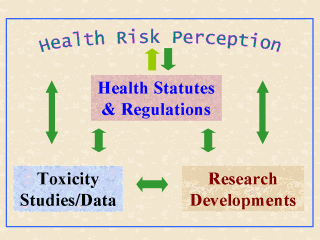| front |1 |2 |3 |4 |5 |6 |7 |8 |9 |10 |11 |12 |13 |14 |15 |16 |17 |18 |19 |20 |21 |22 |23 |24 |25 |review |
 |
Many of the
elements, issues, and concepts presented in this lecture, including this flowchart, appear
to have been wandering around as if they needed a home to stay. Such a deficiency or
problem seems to be inevitable, however, since the interrelationships among these
elements, issues, and concepts are dynamic, tangled, as well as complicated. For example, the last two slides on U.S. regulatory and world actions at first seem to suggest that regulatory agencies are in full control of how health risk assessments should be conducted. However, regulatory guidelines are actually prepared by government health scientists. Before these health scientists are capable of gathering all the appropriate information and data needed to support their scientific decisions, they must bring their understanding and knowledge in line with those of the outside scientists. As expected, regulatory health scientists acquire these abilities through attendance of scientific conferences, interactions with scientists in the industry and academia, and literature review. As another example, the potential use of PB-PK models (as described in Slides 16 and 17) in risk assessment has been receiving a great deal of regulatory attention these days, as evident from their inclusion in recent regulatory agenda (U.S. FDA, 1999; U.S. EPA, 1999c) and guidelines (U.S. EPA, 1999a, 1999b). These agenda and guidelines are made possible not only through the mutual appreciation of these models by toxicologists and administrators in the government, industry, and academia, but also through the recent advances in computer technology and laboratory analysis (of biomarkers and the like). |